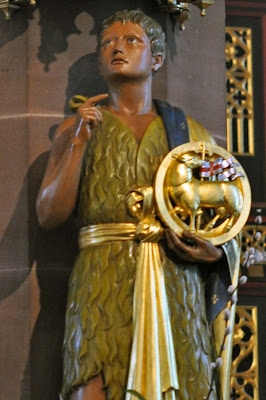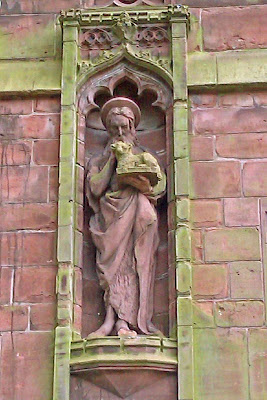Readers in most of England may need some introduction to John the Baptist, as his feast has been little celebrated since the Reformation. A remnant survives in commerce, as it is a quarter day - a day, along with St Michael & All Angels (September), Christmas and the Annunciation (March) on which many quarterly payments of rent etc. fall due.
Readers in Finland will need no introduction - Juhannus, called Midsummer when speaking in English, is one of the principal holidays of the year, celebrated with bonfires and traditional events, and marks the time when many city residents head to the countryside for a few weeks in the open air.
As the church in which I worship is dedicated to St John the Baptist, we have a number of depictions of the saint.
This statue was designed by Sir Ninian Comper, and was installed as a memorial to those men from the parish who died in the Second World War. It is said to have been modelled on Nijinsky, which unfortunately leads someone of my age to think of a horse.
We also have a statue above the north porch, outside the building, which is a more traditional depiction, presumably designed by George Frederick Bodley, as it is a fixture of his building.
The flowing beard, hidden in this picture by the Lamb, suggests a venerable old age, which John did not reach. We know he was about 6 months older than Jesus, and was beheaded before Jesus' Crucifixion, which suggests an age no more than about 30. Again, the hair is in suspiciously good order, and we only catch a glimpse of the camel hair garment under an outer robe.
Of course, it is easier to depict John's likely appearance in paint.
When the south porch was enclosed as part of a corridor to the hall a few years ago, a fresco was commissioned from a Romanian Orthodox artist, Laurentiu Nechita. It depicts Christ in Majesty, flanked by the Virgin Mary and John the Baptist, so we can see John as he is depicted in the Orthodox tradition. The hair and beard are more dishevelled, although the camel hair garment is, strangely, blue. Instead of the Lamb in the statues, John bears the Biblical text, "Behold the Lamb of God" the words that he uttered when Jesus came to him for baptism.
These very different works endeavour to depict John as he is described in his adult ministry. He also appears in Scripture at the beginning of his life, when his father Zechariah declares (by writing, as he has been deprived of the power of speech as a sign that the events revealed to him in a vision will take place), that the child is not to be named after his father, as would have been the custom, but to be called John, meaning "grace".
I am not sure of the wisdom of depicting the infant John in a statue, but someone had a go.
We know little of the provenance of this statue, but it looks like a classic example of mid Victorian sentimental bad taste, described by a former Vicar as a "hideous little gnome". It once occupied the pride of place now taken by the Comper statue, so I think we have a better lot than our forebears in that regard.



